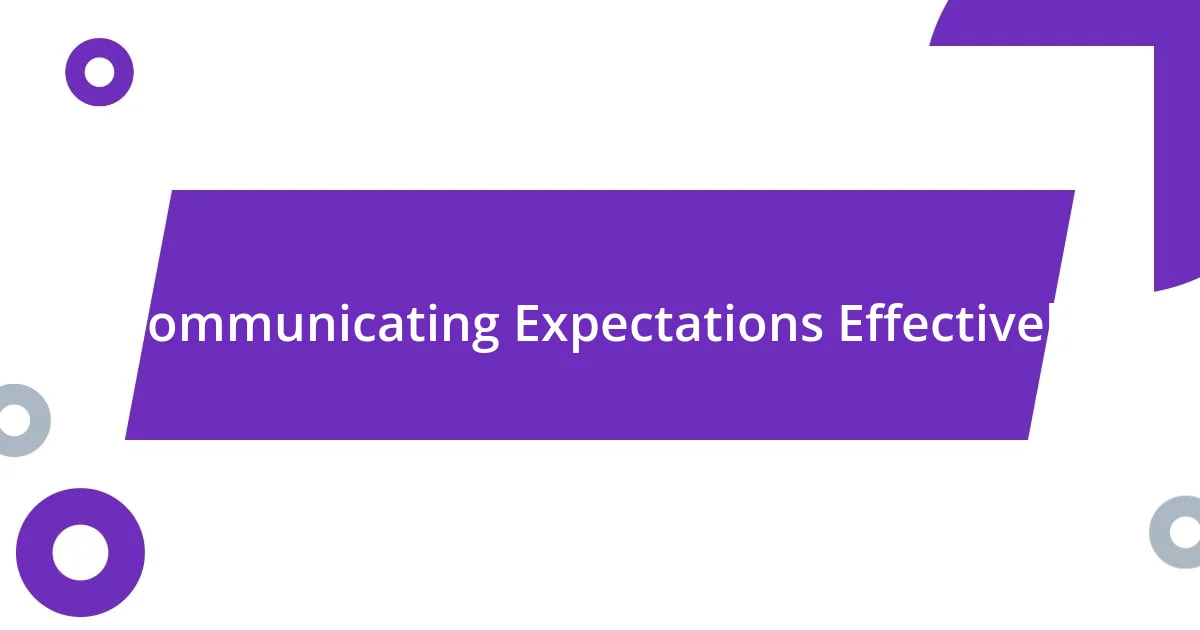Key takeaways:
- Clear entry expectations are essential for fostering collaboration, reducing anxiety, and enhancing overall team performance.
- Effective communication and regular check-ins are crucial strategies for establishing and maintaining clear expectations, allowing teams to adapt and grow together.
- Reflecting on expectations and outcomes can reveal areas for improvement, encourage innovation, and strengthen team dynamics.

Understanding Clear Entry Expectations
When I first encountered the concept of clear entry expectations, it struck me how often I’ve walked into new situations without a solid understanding of what was required. Reflecting on my own experiences, I remember a time when I joined a project team at work, and the lack of clarity left me feeling unsure and frustrated. Why do we so often underestimate the power of clear expectations?
Understanding clear entry expectations means acknowledging that they serve as a roadmap for success. I’ve found that when everyone is on the same page, it fosters a sense of collaboration and confidence. It’s like being handed a script in a play; your role becomes more defined, and it enhances the overall performance.
Have you ever been in a setting where expectations were vague? I know I have, and it can be daunting. Without these clear guidelines, I’ve noticed that misunderstandings creep in and lead to unnecessary stress. It’s crucial to establish expectations right from the start, as it paves the way for a smoother journey ahead.

Importance of Clear Entry Expectations
Clear entry expectations are vital because they lay the groundwork for any successful endeavor. I remember walking into a new role without a clear outline of my responsibilities, and it felt like trying to navigate a maze blindfolded. Each twist and turn led to confusion and frustration, just like many people must feel when faced with ambiguity in new situations. When expectations are well-defined, it’s like pulling the blindfold off and clearly seeing the path ahead.
Establishing these expectations creates a shared understanding among team members, which fosters trust and respect. I’ve seen teams flourish when they know what’s expected of them from the start. It’s crucial for not just individual performance but also for the group dynamic. Without clear expectations, I’ve often witnessed individuals second-guessing their contributions, which can stifle creativity and innovation.
Moreover, clear entry expectations can significantly reduce anxiety. I can recall a time when I joined a volunteer group. Initially, I felt overwhelmed by the lack of direction. However, as soon as the leaders shared their expectations, I relaxed. Knowing what was expected allowed me to focus on contributing rather than worrying about what to do. This clarity is essential for creating an environment where everyone can thrive.
| Benefits of Clear Entry Expectations | Lack of Clarity |
|---|---|
| Fosters collaboration | Creates confusion |
| Reduces anxiety | Increases stress |
| Enhances performance | Stifles creativity |

Strategies to Establish Clear Expectations
Establishing clear expectations is like building a solid foundation for a house; without it, everything feels unstable. One strategy I’ve found effective is to have open conversations early on. When I joined a community basketball league, the coach hosted a meeting where he laid out his vision and what he expected from each of us. That discussion not only highlighted our roles but also encouraged everyone to share their thoughts. I left that meeting with a sense of purpose and enthusiasm, something I believe others also felt.
To further enhance clarity, I recommend the following strategies:
- Create a shared document outlining expectations and responsibilities. This serves as a reference point.
- Encourage questions by fostering an environment where it’s safe to seek clarification. One question could uncover a misunderstanding that affects the whole group.
- Set measurable goals to track progress. I recall working on a team that established milestones; it kept us motivated and engaged.
- Regularly check in to reassess expectations as projects evolve. Adapting as we go can prevent misalignment down the road.
Each of these strategies helps cultivate an environment where everyone feels confident and informed, reducing the angst that often accompanies new challenges.

Communicating Expectations Effectively
Communicating expectations is crucial for establishing a cohesive team environment. I remember a project where each member had different interpretations of our goals, leading to frustration and unnecessary duplication of work. It made me realize that a simple conversation to clarify our objectives could have saved us so much time and confusion. Just think—what if every team leader prioritized open dialogue?
Having clear, concise lines of communication can prevent misunderstandings that often lead to conflicts. I once participated in a workshop where the facilitator encouraged us to voice our expectations at the beginning. The openness sparked engaging discussions, allowing us to align our visions. I felt invigorated knowing that my input was valued; it transformed the atmosphere into one of collaboration rather than competition.
One vital aspect is actively listening to feedback. After outlining expectations in a recent meeting, I asked for everyone’s thoughts. To my surprise, several members shared concerns that I hadn’t even considered. Their insights not only enriched our plan but made me appreciate the diverse perspectives within the group. Isn’t it fascinating how a few thoughtful conversations can significantly shape the direction of a project?

Monitoring Progress and Adjustments
Monitoring progress is essential to ensure that everyone is on the same page. I remember overseeing a community event where we had set specific goals. Initially, I checked in weekly, noting what was working and what needed adjustment. Surprisingly, those small meetings transformed into a platform for team members to express their challenges and successes, which created a supportive environment. Have you ever experienced the relief of having your concerns acknowledged?
In addition to regular check-ins, I’ve found that using visual tools, like progress charts, can be incredibly motivating. When I managed a project last year, I designed a simple chart that displayed our milestones. Each small victory felt like a communal celebration, bringing the team together and igniting our passion for the project’s success. It’s amazing how tangible reminders of progress can fuel determination, isn’t it?
Adjustments should happen organically, reflecting the team’s growth and needs. I recall a situation where we hit a snag due to unexpected challenges. Instead of sticking rigidly to our initial plan, we gathered to brainstorm solutions. This collaborative effort reinforced trust among teammates and taught me that adaptation often leads to even better outcomes. Aren’t those moments of collective creativity some of the most rewarding in a project?

Overcoming Challenges in Implementation
Implementing clear entry expectations isn’t without its hurdles. I once faced a situation where my team was resistant to change, preferring our old ways. It was frustrating, but I realized that the key lay in framing these expectations as enhancements to our processes, rather than mandates. Have you ever noticed how a simple shift in perspective can change the entire team’s mood?
When challenges arise, flexibility becomes paramount. I vividly remember a time when unforeseen circumstances required us to pivot our initial plans. Instead of viewing this as a setback, we embraced the change, working together to redefine our objectives. This experience taught me that adaptability not only keeps progress on track but can also strengthen team bonds. Isn’t it refreshing when unexpected shifts lead to unexpected growth?
The emotional aspect of overcoming implementation challenges can be just as crucial. I often find that addressing hesitations within the team—acknowledging fears and uncertainties—creates a space for honest dialogue. Once, during a particularly tense alignment meeting, sharing my own apprehension about the project helped others express their concerns. The result was an atmosphere of vulnerability that fostered trust. Wouldn’t you agree that tackling those tough conversations can ultimately lead to a stronger foundation for success?

Reflecting on Entry Expectations Outcomes
Reflecting on the outcomes of entry expectations can be quite revealing. I recall a project where we laid out our goals, only to discover that the initial expectations didn’t align with team capabilities. In our first reflection session, we openly discussed how certain targets felt unrealistic. It was eye-opening to see how adjusting those benchmarks not only eased stress but also led to improved performance. Have you ever felt the weight lift after recalibrating your goals?
Sometimes, the most significant outcomes come from unexpected places. I was part of a team that initially struggled with rigid entry expectations, but when we revisited them, we discovered a wealth of untapped potential among team members. The moment we encouraged everyone to voice their thoughts on what they could realistically achieve, it sparked a wave of innovation. Isn’t it fascinating how an open dialogue can transform a challenging situation into a breeding ground for creativity?
Ultimately, reflecting on entry expectations is about growth, both individually and collectively. I often find myself thinking about a project where, after reviewing our progress, we unveiled hidden strengths within the group. One team member, who previously seemed disengaged, brought forth an idea that became a game-changer. That moment made me realize how crucial it is to cultivate an environment where everyone feels valued and included. Would you agree that fostering such inclusivity often leads to transformational outcomes?














